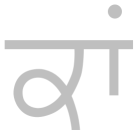
(ਨੌਂ) - ਬਿੰਦੀ - Bindi.
Name: Bindi Shape: ਐਂ, ਕਾਂ, ਓਂ Spelling: ਬਿੰਦੀ Drawing: ਊਂ is a ਊ with a bindi on top. Where the tippee is shaped like a smaller version of the lower half of a ਨ, the bindi is reduced in size further until it has become just a dot (which is what 'bindi' means).
Like tippees, bindis are used to add nasalisation to consonants and this is pronounced at the same time (or shortly after the start of) the vowel sound.
Like tippees, bindis can't be used just anywhere. See below for the listing.
Sound: This is a partial/implicit 'n' - the opening of the soft palette, allowing air to pass through the nose as would happen during an 'n' (ਣ, ਨ) but without closing off the mouth.
Imagine the nasalised 'n' in the 'ah' sound as in the end of the French word for 'naturally'; 'naturellement'.
Bindi/Tippee use:
Bindis and tippees cannot be used indiscriminately - there is a correct choice for each occasion.
They always appear above the joining line so their use is (with one exception) determined by how much space is available - that being dictated by which vowels are used or whether an oordaa is present - oordaa being the only letter that goes above the joining line.
However, oordaa only appears as a vowel carrier so we can make a meaningful table of bindis and tippees with each vowel, using vowel carriers and any other letter.
Mukta ਮੁਕਤਾ ਅੰ ਕੰ Kannaa ਕੰਨਾ ਆਂ ਕਾਂ Sihari ਸਿਹਾਰੀ ਇੰ ਕਿੰ Bihari ਬਿਹਾਰੀ ਈਂ ਕੀਂ Aunkard ਔਂਕੜ ਉਂ ਕੁੰ Dulaenkarday ਦੁਲੈਂਕੜੇ ਊਂ ਕੂੰ Laanv ਲਾਂਵ ਏਂ ਕੇਂ Dulaavaan ਦੁਲਾਵਾਂ ਐਂ ਕੈਂ Hordaa ਹੋੜਾ ਓਂ ਕੋਂ Kanaurdaa ਕਨੌੜਾ ਔਂ ਕੌਂ Key:
Tippee
ਅੰ Bindi
ਓਂ You can see from the above table that nasalisation markings are dominated by bindis and that at first, you might think that the table has little pattern to it. However, there is a simple rule of thumb that makes reason of this.
With the single exception of a kannaa, you get a tippee wherever there is enough space for one.
If you think of it looking better with a bindi; or, just being easier to write (there being so many kannaas with a bindi in Punjabi), then you should remember this exception.
Copyright ©2007-2023 Paul Alan Grosse.
